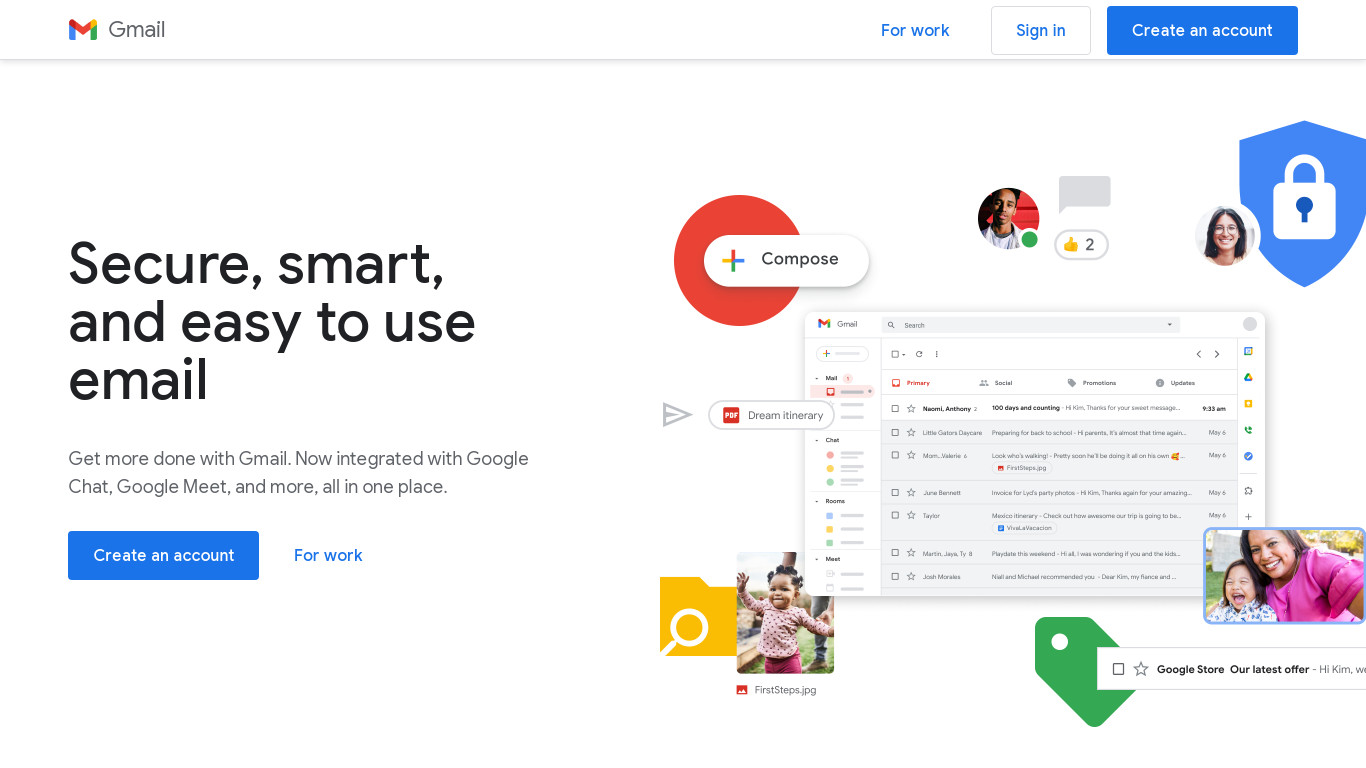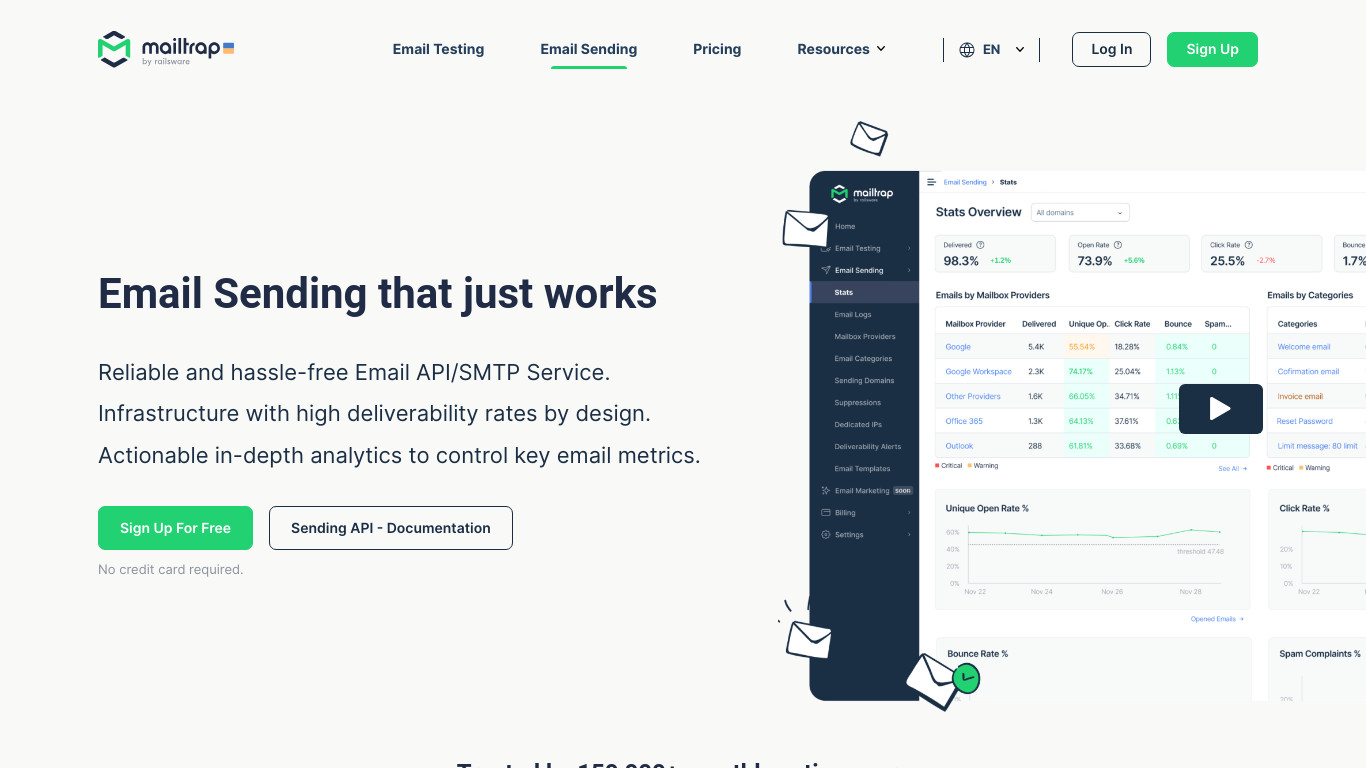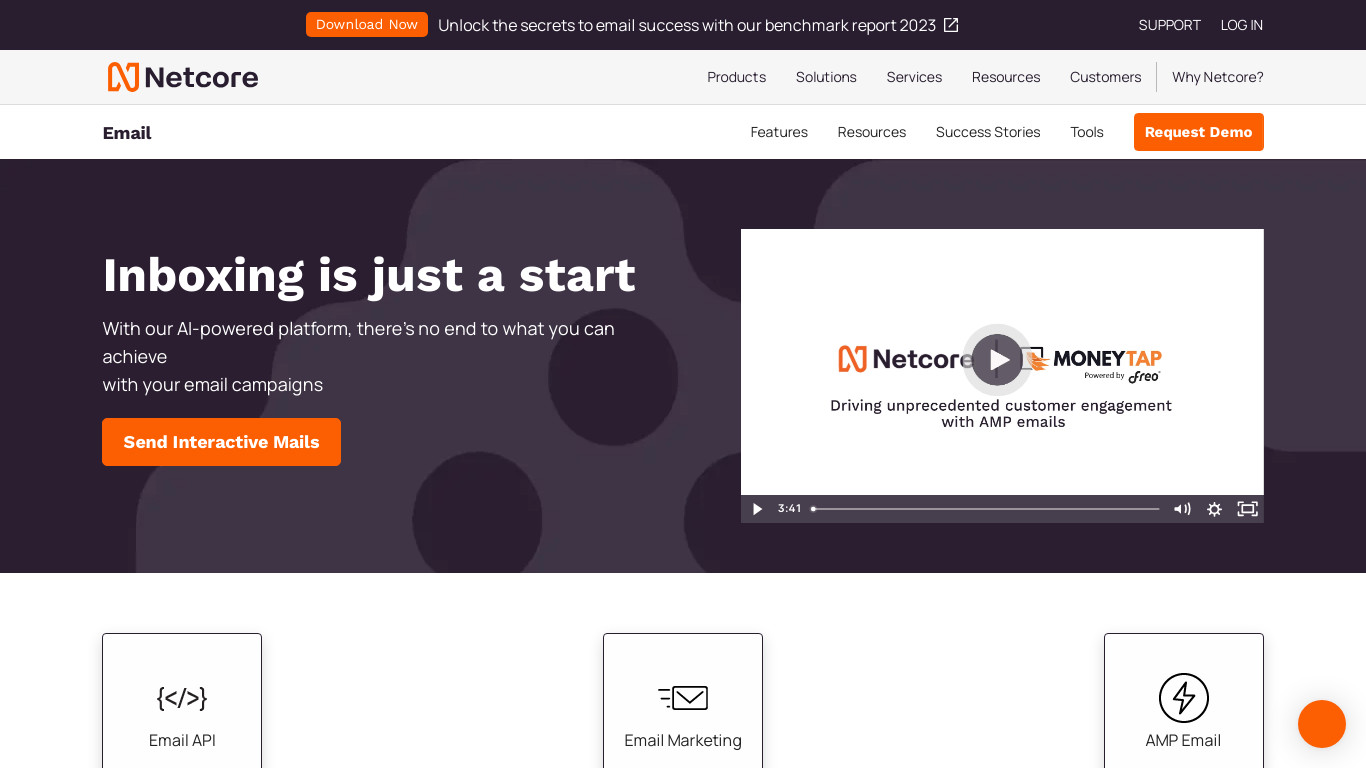Even with many digital marketing trends taking over the internet, email marketing still has several advantages that make it relevant. The best way to engage your target audience is to drop them a well-written mail about your services simply. Email APIs or SMTP relays can send emails to large audiences.
Words like SMTP and API are thrown around a lot, but what do each of them mean? Depending on your use case, an email API integration or an SMTP relay can have more benefits for you. Let's look at these technologies and see the characteristics that set them apart.
What is SMTP and Why You May Need It?
We can send emails across the internet with the help of SMTP - Simple Mail Transfer Protocol. It is the standard protocol used while communicating through emails. This means it is a set of rules and regulations to follow while sending and receiving emails online.
You can send mail via SMTP through a server, over a network, or to its intended recipient. This is done by using an SMTP server. Unlike most computer servers which manage numerous operations concurrently, an SMTP server handles email sending, receiving, and transmission. Many mail services use SMTP to transfer emails across the internet.
How To Use SMTP?
Using SMTP to send an email is simple. SMTP ensures that communications between a person sending an email and its recipient remain confidential and safe. When a user connects to the SMTP server to communicate via email, the server waits for the TCP or Transmission Control Protocol connection and starts a session on that port.
Once the TCP connection has been established, the SMTP protocol gets initiated. The server must verify the mail and credentials after receiving distinct bits of data from the user. Utilizing SMTP instructions and response codes, they communicate with one another. The email is forwarded to the recipient SMTP server if all is in order.
Similar conversations take place between the SMTP servers of the receiver and the sender. The email may be delivered, rejected, or placed in the spam bin. The IMAP - Internet Message Access Protocol - or the POP3 - Post Office protocol - is used to transmit the message to the receiver's client machine.
Unless your network or service provider has barred you, you should utilize port 587 to send emails using SMTP, the standard SMTP port for mail transport. A store or forward approach is used for internal communications within an organization using SMTP, while the end-to-end approach is utilized for external communications.
Pros and Cons of SMTP
There are many benefits to using SMTP servers. It is extensively used, so you don't have to worry about usage and compatibility. Every machine that can send emails makes use of SMTP. It is also simple to configure. All you have to do is set up an account with the email service provider you want to send emails through your email apps.
SMTP requires minimal to no understanding of programming or programming standards. You will receive a clear signal with a specific error page if something goes wrong when using an SMTP. For example, it will show you a 400 or 500 error message.
But SMTP is not without its flaws. First, multiple to and fro communications with the server are necessary for SMTP. Before transmitting an email, its DNS, credentials, and other elements must be validated. There are various alternatives for errors to occur throughout this back-and-forth interaction.
This is because each transmission needs to be verified and given an approved message (250) or an error message (400 or 500). Such to-and-fro interactions can cause slow delivery of mass messages. Creating mail merging via SMTP can also be a labor-intensive and challenging operation.
What is Email API and Why You May Need It?
An Application Programming Interface, or an API, is utilized for several purposes, in contrast to SMTP. API allows various programs and systems to interact and share information. For instance, when you try to register to an internet portal, an API notifies the account's server of what you are doing. Subsequently, it notifies you of the success or failure of the login session.
Essentially, an API can communicate with another piece of code. It has numerous uses, but when used for email, an API is somewhat similar to SMTP. Providers of email APIs handle protocol issues, including message assembling, message transmission, and message monitoring, that would normally need the software team to specify them.
How To Use Email API?
A specific application, such as a web page, could automatically use email APIs to deliver operational mail, such as receipts and confirmations. This is faster than having to schedule and transmit each email manually. Their goal is to offer quick, reliable email functionality without the burden of utilizing a different service or software program.
Imagine you are at a restaurant and choose a food item off the menu. If an API was the menu, the moment you placed your order, that item begins getting prepared. The API provides the programmer with several possibilities, and once they choose a program, they just need to use that program.
The most effective I/O efficiency for email services is guaranteed by email APIs since they significantly minimize the amount of information that needs to be delivered. Programs can deliver key and value sets directly connected to the email content, such as the topic, body, and receivers, instead of completely built emails with header data.
RESTful APIs
An HTTP API that follows the REST design restrictions is called a RESTful API. HTTP is a file transfer protocol, whereas REST is a collection of instructions for using transfer methods like SMTP and HTTP.
Pros and Cons of Email API for sending emails
Using APIs for sending emails has several advantages. An API makes sending messages and managing procedures with your application simple. In general, delivery times for APIs are faster and can be performed quickly. This is mostly because APIs require less to and fro communication for approval.
Additionally, it lessens the chances of an email-sending error. Using APIs can give you access to some very crucial statistics as well. Marketers will find this particularly useful because they need to know how many and how different types of recipients responded to their emails to improve interactions.
By using an API key, API also provides an additional layer of protection. This enables your system to effectively visit your dashboard and carry out email functions. This additional level of protection is particularly crucial if you handle and communicate extremely confidential material via emails.
With this, APIs can enable your application to respond differently to various pre-established conditions. This makes it possible for your application to operate smoothly and be more adaptable. Most firewalls let APIs through them because they use HTTP - Hypertext Transfer Protocol.
Even with all these benefits, APIs also have some cons. The majority of APIs demand an understanding of programming to establish and run. And if this software is incorrect or the individual doesn't know how to utilize it, it may be a nuisance. It is even more difficult to understand the many indicators to be used when sending an email and how they impact your application's usability.
Over time, API version control changes. They frequently need to be updated and modified to stay up-to-date with the modifications. In contrast, SMTP is a standardized protocol for email sending, and it does not face this problem.
Email API vs. SMTP: Which One to Choose And When
Now that we've seen the pros and cons of email APIs and SMTP, which of them should you choose? The answer to this question depends on your application and the conditions under which you are sending your emails.
Your decision between the two should be based on your requirements and the project's demands. Email reliability is a key component of SMTP and API email transport techniques. But the methods they employ are different. SMTP entails the handshake method between the client and server.
SMTP is a viable option if you are an informal sender who requires simplicity for routine activities. It can be used to connect with your email client or CRM program. Unlike SMTP, a Web API speeds up transmitting because less back and forth is needed. APIs also let you automate your operations and monitor KPIs.
Comparison Table
| Email API | SMTP | |
| How does it work? | API is the communication method used by different applications or platforms.
API is a window to relay another utility or code. |
SMTP is the set of rules or protocols to send an email across the servers.
SMTP lets your system create emails and send them to the server. |
| Pros | Using email API makes the process faster and reduces the chances of failure.
APIs add an extra layer of security to your emails. |
SMTP is more widely adopted as compared to APIs.
Using an SMTP requires no knowledge of coding. |
| Cons | API requires knowledge of coding to be able to operate easily.
There is also a need for constant updates and modifications. |
SMTP requires a lot of back & forth communication with the servers at certain points.
Mail merging with SMTP can sometimes be a complicated process and might take a lot of time. |
When Should You Use SMTP For Email Sending
If your application can't add API, you need to use SMTP to send your emails. This includes situations where third-party programs created especially for you cannot interface with API. Moreover, consider the situation if you already use SMTP for an older version or transmission mechanism. In this case, sticking with SMTP rather than attempting to switch to a new email service provider may save you energy, cash, and time.
When Should You Use an API For Email Sending?
Using APIs for sending emails is recommended if you can incorporate them into your applications. They can be used for commercial and bulk mail just like SMTP, but they offer the benefit of being quicker and more adaptable.
If you have an online business, you must be able to send emails on a mass scale. You can't send each of your customers and target audiences personalized emails. This process can be automated with the help of an API. You can manage emails and link messages to prompted events using an email API.
In contrast to SMTP, an API can be readily programmed to perform any task at any time. If your customers make a purchase, email APIs can send receipts instantly. They can also send your clients' updated emails that tell them where their order is. This optimizes your service and improves your client interactions. You don't have to do all the periodic updates yourself.
Your consumers will have more faith in you and are more inclined to return for more business if they consistently receive the required invoices. An email API is a terrific approach to maintaining these emails without hassle. It also frees up your and your employee's time which can be spent on other valuable tasks.
Email API vs. SMTP: A Difference In Email Testing
Before publishing your emails, testing to ensure your content, design, and layout are functional is a good idea. You need to look at how both SMTP and Email API work regarding email testing. This can help you decide among them based on your testing capabilities.
Since the server and the client often communicate, troubleshooting regarding SMTP email testing is not difficult. To conduct such a test, you must connect to the SMTP server and attempt to send an email.
If you get the email successfully, your server is working. If you don't receive the email for some reason, you will always receive a code describing the failure. This can help you understand which part of the system is not working.
Because they have more intricate designs, REST APIs call for an all-encompassing testing strategy. When examining a web API's performance, you should also be prepared for some difficulties.
Testing indicator selection and arrangement, in addition to call scheduling, are difficult tasks that require programming expertise. Since no GUI (Graphical User Interface) is accessible for evaluating the application, providing input data to evaluate the exception processing mechanism is more difficult.
Top 6 Providers of Both SMTP Relay and Web API Services
We have seen where and when you should use SMTP and web APIs. But how can you integrate them into your application? To do this, you will need email service providers. Here are six providers that let you use both SMTP and API services:
Gmail

Gmail is among the most well-known email service providers, and Google offers both SMTP and the REST API for free. Various online code examples contain references to the smtp.gmail.com server. Additionally, the REST API sets many patterns and is an excellent choice for newcomers.
Mailgun

Meant to be used by programmers, Mailgun is a completely commercial email service. You may send, reply to, and monitor emails using the robust email APIs that are provided. The SMTP relay service offered by Mailgun is a good option if you want a more conventional method of email transport. It provides 10,000 emails for free each month.
Integrating it into a webpage is simple. Mailgun provides an easy-to-scale SMTP solution for sending your commercial and marketing emails, regardless of the size of your business. It excludes a few beginner-friendly capabilities of other SMTP carriers as it is intended for developers.
Mailjet

Another product that caters to both retailers and programmers is Mailjet. For their requirements, the programmers can take advantage of SMTP relaying and Send API. You can decide on the one you want to use based on your needs.
Mailtrap

Mailtrap Email Delivery Platform is an end-to-end sending solution for devs to test, send, and control emails in one place. You can inspect and debug emails in staging with Email Sandbox and send them on production with reliable Email API/SMTP service.
Also, Mailtrap allows users to catch and fix early-stage sending issues with an actionable analytics toolset: timely deliverability alerts, 60-days email logs, and dashboards with all critical metrics.
Sendgrid

You can use the Web API to send and monitor emails, where Sendgrid concentrates its attention. But this service's main function is as a cloud-based SMTP service. Sendgrid provides an SMTP API in addition to email APIs. You can expand SMTP's abilities by including JSON commands in emails for further event monitoring.
With a robust set of features, it provides greater scalability. Their SMTP relay is simple to set up, and it has connectors with third-party applications and services, email monitoring, templates with an easy email designer, and distribution optimization features.
SendGrid provides excellent solutions to optimize email delivery further if reliability is your top priority, like specialized IP addresses and website domain security mechanisms.
NetcoreCloud (formerly Pepipost)

NetcoreCloud offers a sophisticated SMTP relay solution and email APIs for integration with various programming frameworks. Pepipost offers SMTP services through the cloud. You can send emails using this SMTP relay service without stressing the email servers. It is a straightforward email delivery service made for programmers.
To Wrap It Up
Both SMTP and email APIs have their pros and cons. Specific use cases will perform better with conventionally used protocols like SMTP, while more specific services may need API integration. You can review the information above and see which email services work for you.
Although quite dependable and long-lasting, SMTP relays cannot provide high-speed transmission. In contrast, though it is more difficult to use, web APIs offer more excellent capabilities.
Understanding their advantages and disadvantages and how to use these services is essential. Only then can you make an informed choice about which is right for your application? You should think about the ease of email testing as well.
Regardless of these two choices, several capable email service providers can help you integrate them into your application without difficulty.






